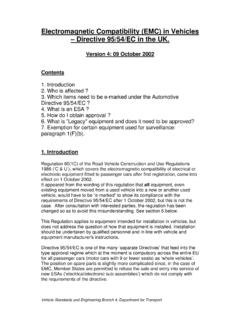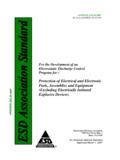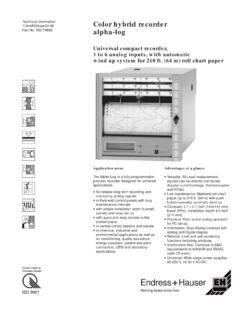Transcription of Electrostatic Discharge Testing for - autoemc.net
1 12 Conformity february 2007 ESDby Martin O HaraElectrostatic DischargeTesting for Automotive Applicationsunderstanding Differences from Commercial eSD Testing is Key to Successful Compliance Photographer: Sascha burkard | agency: 2007 Conformity 13 The international automotive ESD standard (ISO 10605: 2001) has significant differences from the commercial ESD Testing standard (IEC 61000 4 2). Differences include the human body model (HBM) used to simulate a person s electrical network and the utilization of significantly higher Discharge voltages, up to 25kV air is the automotive standard so different? Does it make sense for it to be different and what are the implications for Testing to this standard for non automotive applications?This article aims to examine the differences and consider why they exist. The test methods will be explained and the similarities between the automotive and commercial product standards also highlighted.
2 A discussion will also be forwarded on why other non automotive products might be improved if they were designed to meet the automotive ESD standard and why this standard might be more appropriate in some non automotive situations than IEC 61000 4 automotive ESD standard (ISO 10605: 2001) is based on similar models and premises as the commercial standard, essentially derived from IEC 801 2:1991 (Electromagnetic compatibility for industrial process measurement and control equipment Part 2: Electrostatic Discharge requirements, now IEC 61000 4 2). The test simulates the effect of a human body Discharge of static electricity, a relatively common occurrence experienced by most vehicle users, usually when entering or exiting the vehicle. Until 2001, the standard was only released at the level of technical report (ISO TR 10605: 1994) and had not been fully adopted as an international standard.
3 The changes between 1994 and 2001 were mainly the inclusion of an unpowered ESD test that reflects handling of an electronic sub assembly (ESA) while in transit or during assembly fit ( , not in situ on the vehicle). The ISO 10605 standard includes Testing on vehicle as well as Testing of individual standard was widely used by vehicle manufacturers (VMs) prior to its full adoption by ISO and included within many VM EMC specifications, including the unpowered test before this was included in this ISO standard. The unpowered test was also included in the automotive ESD standard SAE J1113 13 prior to the adoption by ISO. The Human Body ModelThe human body model (HBM) consists of a single capacitor that is charged up to the required test voltage, and then discharged through a series resistor to the ESA under test, simulating the charge accumulation on a person then Discharge to the ESA/vehicle.
4 Although the HBM premise and component types are the same as commercial standards, the HBM component values are different for the automotive test, in particular the resistance is typically several hundred Ohms in commercial test standards (330 ) rather than 2k used for vehicle test. At first, many observers coming from the commercial field have difficulty understanding why the HBM has different values. The commercial standard is derived for products that essentially have a reference that can connect directly or indirectly to the ground/earth reference that the body has been charged in reference to. However, in an automotive application, the vehicle and/or ESA during handling is in fact isolated from the earth reference. Hence, the Discharge is capacitor (human) to capacitor (ESA or vehicle). Consequently, not only does it make sense for the HBM to be different for the automotive environment, it would be wrong to test automotive components with the earth referenced Discharge model of the commercial standard.
5 It could even be argued that any equipment that is powered solely by battery power should also be only tested to this automotive ESD standard rather than the commercial IEC 61000 4 1: ESD ModelsNoveon Conductive Polymers provides the widest selection of ESD protection materials available today. CompletelineofmaterialsforESDprotectioni ndependentof process: injection molding, thermoforming and extrusion Single-sourcematerialsupplierforanyproce ssortechnology Globalmanufacturinganddistributionprovid ing localizedservice Materialsmeetingtoday sESDµ-contaminationstandardsC A R B O N A L L O Y S Y S T E MSTMELECTROTMC O N D U C T I V E C O AT I N G S Y S T E Stat-RiteisaregisteredtrademarkofTheLubr izolCorporationTMCarbo-RiteandElectro-Ri tearetrademarksofTheLubrizolCorporation 2006 TheLubrizolCorporation22828 NOV Conformity ad_statrite1 18/18/06 9:31:01 AM1 Conformity february 2007 Some commentators believe the higher resistance gives the impression that automotive ESD is an easier standard to meet than commercial ESD.
6 However, the Discharge voltages are higher (up to 25kV), hence the actual energy impact is similar. In fact, most automotive ESAs tend to have a higher immunity to ESD in practice than many commercial equivalents when tested under the same Discharge and HBM conditions. Test EquipmentThe test equipment for ESD Testing is relatively simple in comparison to most EMC tests. The tests can be performed over a simple 1mm thick metal ground plane at least 1m2, and the ESD Discharge device (usually termed an ESD gun ) consists of a power supply capable of generating the appropriate test voltage and a test Discharge head containing the appropriate human model components with switch. The tests do not need to be conducted in a screened room, although this is occasionally the case within test laboratories as the air Discharge tests can register as radiated noise on nearby sensitive receivers if not ESD power supply should to be capable of generating 25kV to meet ISO 10605 requirements, although this level may not be required for many tests.
7 The Discharge head is usually changeable with loads for the 2 human body models (both resistor and capacitor are usually contained in the test head) and combined with a spherical test probe for air Discharge and a pointed probe for contact Discharge (see Figure 2). These probes are identical to non automotive ESD test probes based on IEC 61000 4 PulseThe output pulse shape from the ESD gun is not usually displayed and, if it is, it is usually in volts, but the ISO standard gives the pulse shape in amperes for calibration purposes (see Figure 3). The automotive ESD test can appear less severe than some of the commercial standard tests, not only due to using a higher resistor value in the HBM, but also a slower minimum rise time of compared to that can be used in contact Discharge in commercial standards. Rise time for air Discharge is also relatively slow at under 5ns.
8 These rise times are calibrated from test contact discharges into 2 test slower rise time for air Discharge reflects the isolation of a vehicle from the common earth reference. Even during transport and handling of ESAs (particularly user installed after market products) the device is still isolated from the earth reference. Hence, it could be argued that the automotive ESD standard is still applicable for any device (automotive or otherwise) that is either battery powered or handled when disconnected from its supply. As with most automotive EMC standards, there are options on the severity of Discharge used (although not on the rise time itself).The peak currents contained in the test pulse give some indication of how severe these tests can be and the peak current levels used in automotive ESD Testing are comparable to commercial ESD peak current is applied for a very short period if a Discharge occurs (insulated bodied devices may experience no Discharge ), but this is followed by a longer Discharge at lower current level after this initial peak (see Figure 3).
9 The second Discharge time is dependant on the human body model used ( the capacitance of the model).Test Voltage LevelThere are 6 different voltage levels that can be applied to a powered ESA, depending on the severity level and the method of Discharge (air or contact). There are 4 severity Figure 2: ESD Test ProbesFigure 3: Test Pulse ShapeLevelIndicated Voltage (kV)First Peak Current (A)Rise Time (ns) - 1: ESD Test Pulse ParametersHuman Body ModelC (pF)RC (ns)a) Inside Vehicle 330600b) Outside Vehicle150300 Table 2: Time Constants for Human Body ModelsSafe Bet!AR Starprobe laser probes have 3 levels of safetyNo other probe manufacturer protects your equipment and the reliability of your data as effectively as AR. Our family of laser-powered E-field probes provides three levels of safety: A mechanical shutter closes automatically when a fiber optic cable connector is removed The laser shuts down if the loop-back path is broken A loop-check is performed every couple of millisecondsPerhaps other manufacturers don't understand that even the smallest error can be disastrous.
10 Or maybe they just don't 's another safe bet: You could search the world over and never find another 3 MHz to 18 GHz laser-powered probe. AR'sStarprobe 3 (Model FL7018) is the first and only. We also redesigned one of the original Starprobes to meet the new IEC 6 GHzrequirements (now Model FL7006).There's now a whole family of these highly intelligent, laser-powered probes that adapt to their environment and provide optimumlinearization, temperature compensation, control, and communication functions. Along with the 5 kHz to 30 MHz probe (Model FL7030),two laser probes that cover 5 kHz to 18 GHz and the world s largest line of field monitoring equipment, why take chances with anything else?To learn more, visit or call us at instrumentationOther ardivisions: modular rf receiver systems ar europeUSA 215-723-8181. For an applications engineer, call Europe, call ar emv United Kingdom 441-908-282766 ar emv France 33 -1-47-91-75-30 emv Germany 89- 614-1710 emv Netherlands 31-172- 423-000 ISO 9001:2000 CertifiedCopyright 2007 AR.










